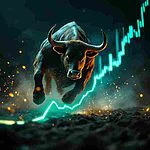
The Anatomy of Panic: When the Market Cracks Open
Apr 21, 2025
Imagine this: a tidal wave of red sweeping across your portfolio, obliterating months, years, decades of work. The market isn’t just sinking—it’s imploding, swallowing wealth, sanity, and optimism whole. This isn’t hyperbole. This is history, repeating itself in violent cycles that too many are unprepared to face. Market fluctuations are not random—they are engineered chaos, a battlefield where only the cunning survive. If you don’t know how to safeguard your investments against market fluctuations, Yahoo Finance will be the least of your concerns. You’ll be drowning before you even get to the lifeboat.
Panic is the great equaliser. It doesn’t discriminate between the seasoned investor and the wide-eyed amateur. It hijacks your brain at its most primal level, sending cortisol surging through your system and shutting down rational thought. The fear becomes contagious, spreading like wildfire through the herd, triggering selloffs that spiral into devastation. The dot-com crash of the early 2000s, the 2008 financial meltdown, the COVID-induced market collapse—all of these moments were defined by panic, not logic. And yet, in every one of these crises, there were those who emerged stronger, wealthier, and more powerful. The difference? They understood the anatomy of panic and turned fear into fuel.
The Wolves Move Different: Decoding the Contrarian Mindset
The herd runs blindly toward the cliff, but the wolves move differently. They circle the chaos, watching, waiting, calculating. Jesse Livermore, the infamous speculator who shorted the market during the Great Depression, once said, “The stock market is never obvious. It is designed to fool most of the people, most of the time.” He understood what so many fail to grasp: markets are psychological games, and the winners are those who master the minds of the masses.
John Templeton, another legendary contrarian, built his fortune by doing the unthinkable—buying into maximum pessimism. During World War II, when others were fleeing the markets, Templeton invested aggressively in companies everyone else had written off. His success was not luck; it was vision. He saw what others couldn’t: that despair is temporary, but opportunity born from chaos can be eternal.
Today, the wolves wear different disguises. They are hedge fund managers who profit from volatility, quant traders who exploit algorithmic inefficiencies, and private investors who understand how to safeguard your investments against market fluctuations that Yahoo Finance algorithms fail to predict. They don’t chase headlines. They don’t follow the crowd. They move with precision, guided by a blend of strategy, intuition, and cold, hard analysis.
Fear as Fuel: The Art of Strategic Options
Fear is not the enemy—it’s the accelerant. The key is knowing how to harness it without letting it consume you. One of the most effective strategies for turning fear into profit is selling put options during VIX spikes. When the market is panicking, implied volatility surges, inflating option premiums to absurd levels. By selling puts on high-quality stocks or indices, you can collect these premiums while positioning yourself to acquire assets at discounted prices if the market dips further.
But the real magic happens when you reinvest those premiums into LEAPS (Long-Term Equity Anticipation Securities). LEAPS are essentially long-term call options that allow you to control significant amounts of stock for a fraction of the cost. This strategy is elegant chaos—a way to use short-term fear to build long-term leverage. Imagine deploying this during the COVID crash, collecting inflated premiums from put sales, and using that cash to buy LEAPS on companies like Tesla or Amazon. As panic subsided and the market rebounded, your gains would have compounded exponentially.
This isn’t just theory—it’s a blueprint for navigating the storm. It’s how you safeguard your investments against market fluctuations, Yahoo Finance won’t warn you about until it’s too late. It’s controlled aggression, a sniper’s approach to risk-taking that maximises reward while minimising exposure.
Calculated Aggression: The Blueprint for Risk
This is not a game for the reckless. Calculated aggression is the art of taking bold positions with a disciplined, methodical approach. It’s the difference between a gambler and a strategist, between YOLO trades and precision warfare. The key is understanding that risk is not something to fear—it’s something to manage.
Think of risk as a chessboard. Every move has consequences, and every piece interacts with the others in ways that can either amplify or mitigate danger. Before you make a move, you must consider every angle: What’s the worst-case scenario? What’s the probability of success? How does this decision align with your broader strategy? Calculated aggression means embracing risk, but only when the odds are in your favor and the potential rewards justify the exposure.
This mindset is what separates the amateurs from the professionals. It’s why hedge funds use algorithms to stress-test their portfolios, why Warren Buffett holds billions in cash during bull markets, and why contrarians thrive when others panic. Calculated aggression is how you safeguard your investments against market fluctuations. Yahoo Finance will analyse only in hindsight. It’s not about avoiding risk—it’s about mastering it.
The Exit Velocity of Independence
The ultimate goal isn’t just financial security—it’s independence. True independence means escaping the mental prison of the mob, breaking free from the noise, and reclaiming control over your decisions. It’s about more than money—it’s about power. Power over fear. Power over uncertainty. Power over a system designed to exploit the uninformed.
To achieve this, you must cultivate a mindset of relentless self-reliance. This means educating yourself, questioning conventional wisdom, and staying disciplined even when the world around you is losing its mind. It means knowing how to safeguard your investments against market fluctuations, Yahoo Finance won’t shield you from. It means seeing the market for what it truly is: a battlefield where only the prepared survive.
The exit velocity of independence is not just about escaping the valley of despair—it’s about launching into a realm of unlimited potential. It’s about turning fear into fuel, chaos into opportunity, and risk into reward. It’s about becoming the wolf, not the sheep.










